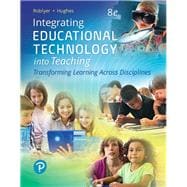Long recognized in the field as the leading educational technology text, Integrating Educational Technology into Teaching links technology integration strategies to specific learning theories, shows pre- and in-service teachers how to plan for technology integration, and offers opportunities to practice integrating technology by designing curriculum to meet teaching and learning needs. Carefully selected exercises, sample lessons, and recommended resources encourage teachers to reflect on their practice as they develop the insights, knowledge, and skills they need to infuse technology across all disciplines.
The 8th Edition features updated technology integration and assessment frameworks, helping teachers employ technology in a way that revitalizes students’ interest and engagement in learning. Throughout the book, content is updated to align with the latest ISTE Standards for Educators and Students and showcases the most current tools, methods, and ideas shaping the role of technology in education.
Integrating Educational Technology into Teaching is also available via Revel™–an interactive learning environment that enables students to read, practice, and study in one continuous experience.









